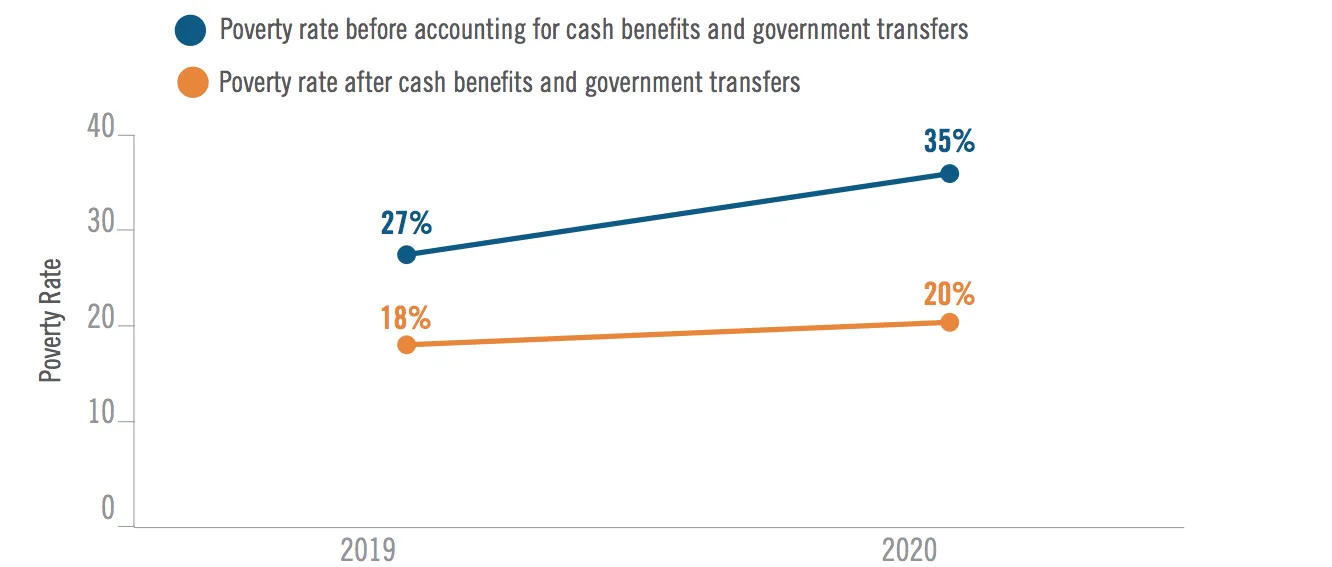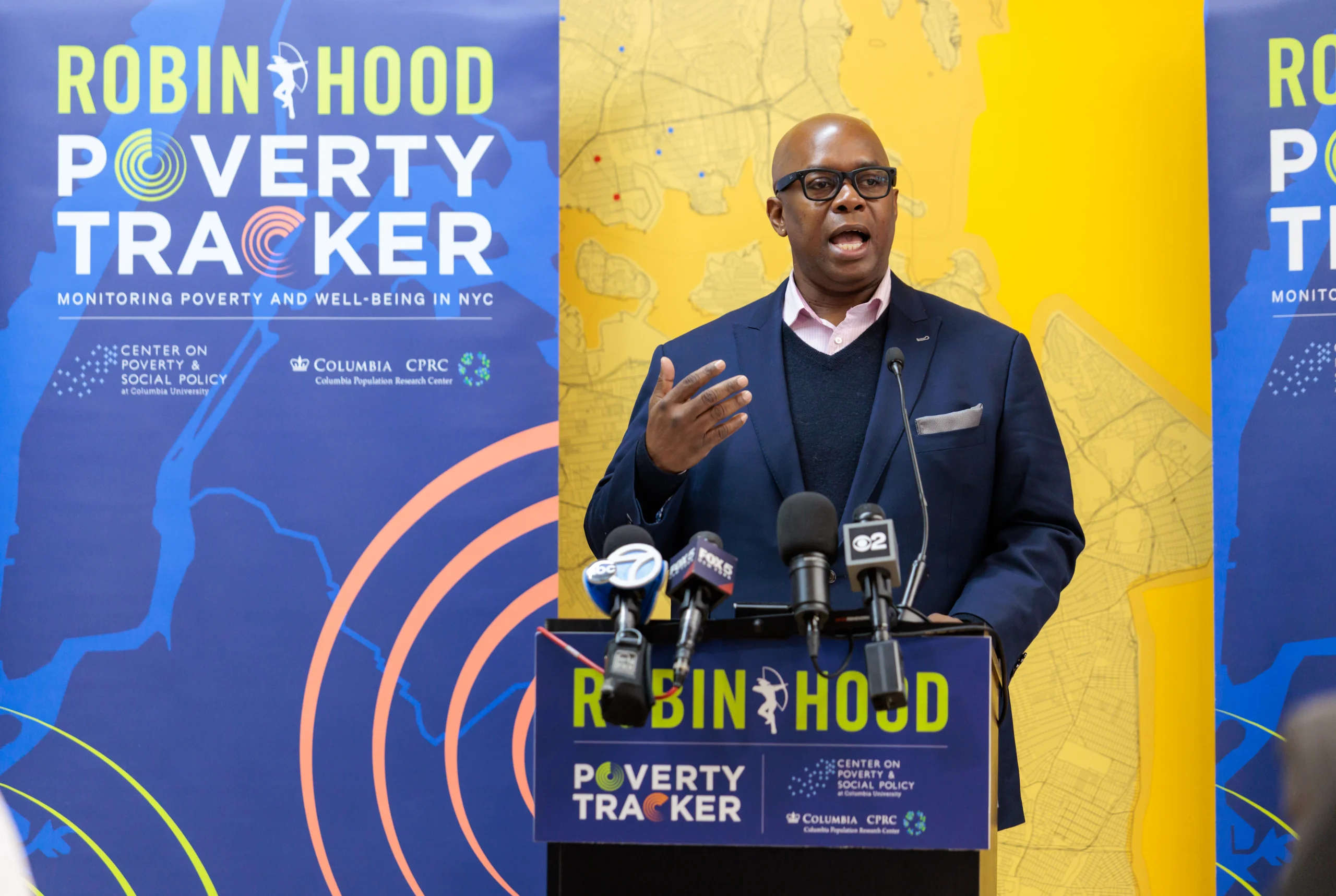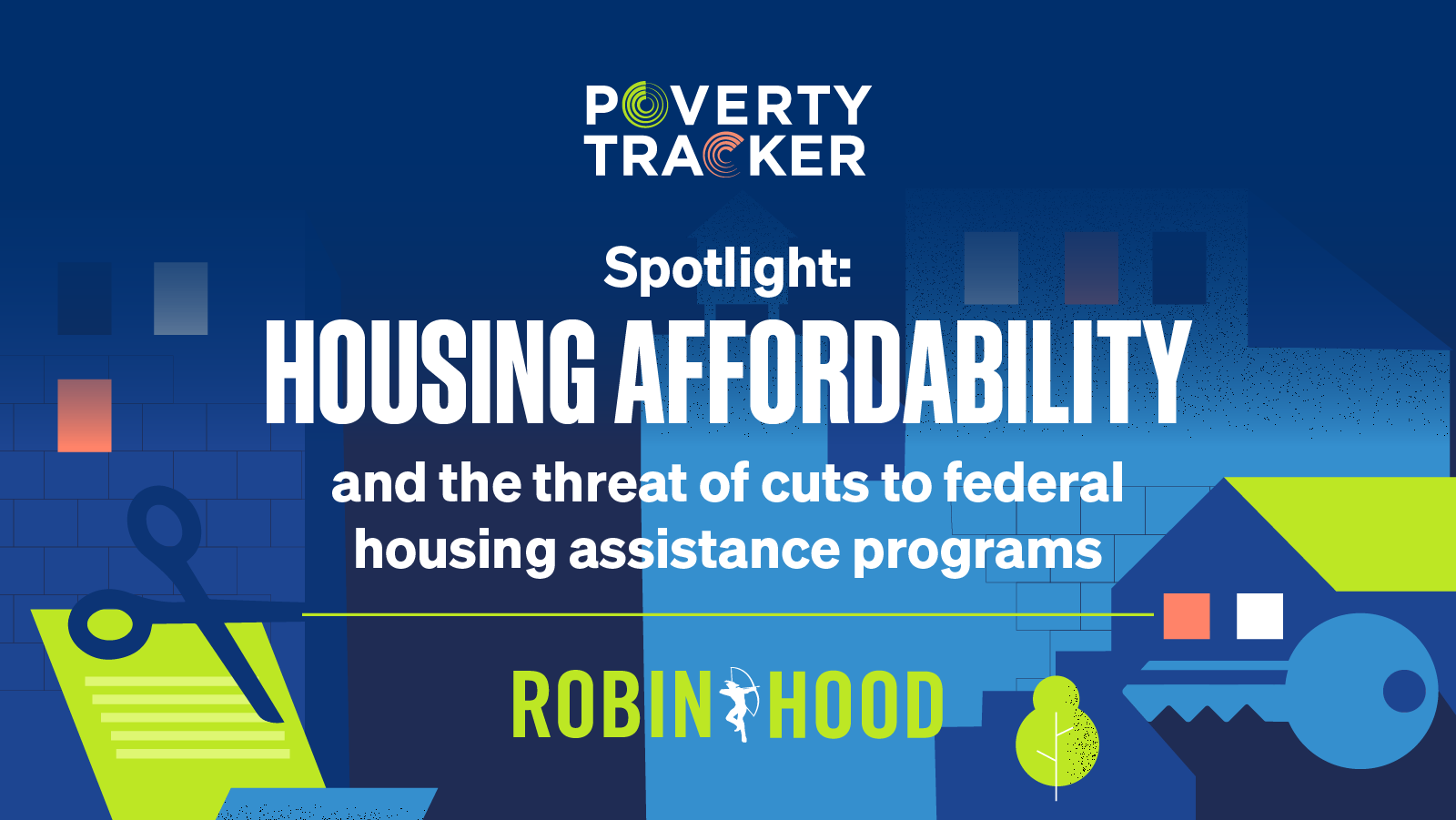Oct 07, 2021
The Power of Cash in Fighting Poverty
By Jon Goldman, Manager | Grant Strategy

Preliminary estimate of the impact of government transfers, including cash benefits, on the New York City adult poverty rate in 2019 versus 2020.
Direct cash payments were the single most useful tool for helping New Yorkers weather the depths of the pandemic.
A new report out this week from Robin Hood’s Poverty Tracker shows how cash payments provided through the Coronavirus Aid, Relief, and Economic Security (CARES) Act, including stimulus payments and expanded unemployment insurance benefits, helped New Yorkers survive during the COVID-19 pandemic. This report builds upon an earlier Poverty Tracker report that said cash benefits and government transfers — including stimulus checks and unemployment insurance (UIB) — slashed the poverty rate by nearly half (43% ), keeping approximately one million adults in New York City out of poverty.
In interviews with 38 New Yorkers over the course of nearly a year, the Poverty Tracker found that people used their unemployment insurance and stimulus money prudently and strategically, paying rent and bills while also avoiding future financial crunches by paying off credit card debt and setting money aside for emergency funds.
A dad named Bae and his wife, both Chinese-Americans who lost their jobs, were interviewed by the Poverty Tracker. Their combined income of nearly $95,000 a year plummeted to zero. The stimulus payments and UIB helped them keep their home and pay for their basic needs. Lucia, 32, was able to reduce her debt from $15,500 to $8,000, thanks to stimulus funds and unemployment insurance.
The Poverty Tracker findings showed that while New Yorkers benefited greatly from stimulus funds and UIB, they didn’t consider it a substitute for work. It gave people breathing room while unemployed, but did not change their desire to seek employment. These benefits also allowed New Yorkers to make the difficult decision to reduce work to stay home with suddenly homebound children, to pay down accumulated credit card debt, and to cover emergency medical expenses.
This is why about half of the $82 million Robin Hood has provided through the Robin Hood COVID-19 Relief Fund has been in the form of direct cash assistance to individuals and families. We knew we could act faster than the government (our first relief grants were distributed six weeks before the first stimulus checks arrived) and we knew that many New Yorkers would be excluded from government support. Over one million New Yorkers living in a household with someone who is undocumented were ineligible for financial support through the $2 trillion CARES Act. And our experience through 9/11 and Superstorm Sandy showed how important it is that these solutions are rapid, human-centered, and serve those precluded from public support.
The New England Journal of Medicine (NEJM) recently published a case study that reflected on the design and outcome of one such program. In partnership with New York City Health + Hospitals (NYC H+H) and the New York Disaster Interfaith Services, we launched the COVID-19 Emergency Financial Hardship Grant Program, a $3 million fund that provided one-time, unconditional cash transfers of $1,000 to low-income New Yorkers diagnosed with COVID-19 and experiencing financial hardship. This partnership made NYC H+H the first health care system in the nation to address social determinants of health directly by distributing an unconditional cash grant to low-income patients with COVID-19.
Unsurprisingly, the NEJM case study found that cash recipients used the support towards basic needs. They used funds to pay rent, buy food, and pay other expenses such as utilities and even medical supplies like oxygen.
We also have the privilege to partner with community-based organizations across the city that are deeply embedded in their communities. Located in the heart of Jackson Heights, New Immigrant Community Empowerment (NICE) runs the only job center for undocumented immigrants in Central Queens and has been an anchor in the community for two decades. The immigrant community served by NICE — which extends beyond Jackson Heights and across all five boroughs — was among the earliest communities devastated by COVID-19. Dozens of NICE’s members died and thousands more lost work and have fallen further into poverty.
Because almost all of NICE’s members are undocumented immigrants, they did not qualify for any funding under the CARES Act, nor any subsequent federal funding. NICE’s ability to remain in constant contact with its members gave them a unique connection to some of the hardest hit individuals in the country. Our $1.5 million fund for NICE’s network, and many others stood up by groups like the Street Vendor Project and Worker’s Justice Project provided critical cash support when public institutions failed.
When looked at together, the emergency cash assistance programs like those established with NYC H+H and NICE, and public supports like stimulus payments and unemployment benefits have been incredibly effective at blunting the economic burden of the pandemic. And while the economic effects of this immediate crisis may be receding, governments and funders should consider direct cash payments a powerful poverty-fighting tool that — critically — supports people with dignity and humanity.
About the Poverty Tracker
Launched in 2012, the Poverty Tracker surveys a representative sample of New Yorkers every three months, providing critical information on the dynamics of poverty and other forms of disadvantage in the city. In addition to measures on poverty and disadvantage, the Poverty Tracker collects a wealth of information on other topics such as employment, assets and debts, and health. The Poverty Tracker has monitored the impacts that COVID-19 and the related economic downturn has had on life in New York City since the onset of the pandemic. The majority of the results presented in this report come from the Poverty Tracker’s COVID-19 Surveys, which were specifically designed to quantify the pandemic’s impact on employment and experiences of material hardship and disadvantage.



